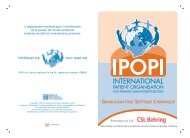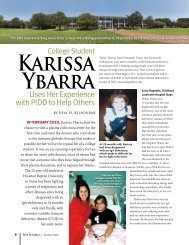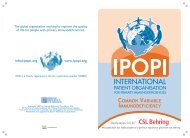IDF Patient & Family Handbook for Primary Immunodeficiency ... - IDFA
IDF Patient & Family Handbook for Primary Immunodeficiency ... - IDFA
IDF Patient & Family Handbook for Primary Immunodeficiency ... - IDFA
You also want an ePaper? Increase the reach of your titles
YUMPU automatically turns print PDFs into web optimized ePapers that Google loves.
60<br />
Hyper IgE Syndrome<br />
Clinical Presentation of Hyper IgE Syndrome continued<br />
Bone fractures occur with seemingly insignificant<br />
trauma, and bone density may be reduced.<br />
Curvature of the spine (scoliosis) is common and<br />
needs to be monitored as children with HIES<br />
grow so it can be treated if necessary. Fused skull<br />
bones (craniosynostosis), and extra or abnormally<br />
<strong>for</strong>med ribs or vertebrae are also found more often<br />
than in the general population.<br />
Teeth<br />
Retention of primary (or baby) teeth in HIES<br />
patients appears to be quite a consistent finding.<br />
Reduced resorption of primary tooth roots<br />
leads to failure to shed primary teeth, which in<br />
turn prevents the appropriate eruption of the<br />
permanent teeth. After an X-ray to make sure the<br />
permanent teeth are present, children who have<br />
had retained primary teeth extracted have had<br />
normal eruption of their permanent teeth.<br />
Other Clinical Findings<br />
<strong>Patient</strong>s with HIES are also at increased risk <strong>for</strong><br />
malignancies, especially lymphoma. Systemic<br />
lupus erythematosus and other autoimmune<br />
diseases have also been associated with HIES.<br />
Diagnosis of Hyper IgE Syndrome<br />
In the absence of a known gene or definitive<br />
test <strong>for</strong> HIES, the diagnosis must be made on a<br />
combination of clinical and laboratory findings. An<br />
elevated level of serum IgE alone is not sufficient<br />
to make the diagnosis since patients with certain<br />
conditions such as severe allergic skin rashes<br />
occasionally have IgE levels in the HIES range<br />
without having HIES. An IgE of over 2,000 IU/ml<br />
(normal adult value is less than 100 IU/ml) has<br />
been used as a cutoff level <strong>for</strong> HIES when other<br />
features including boils and pneumonia are present.<br />
In infants, in whom normal IgE levels are very low,<br />
an IgE of 10 times the age-appropriate level is a<br />
reasonable guide <strong>for</strong> HIES. It should be noted that<br />
in some adults with HIES, IgE may decrease and<br />
even become normal. The presence of the other<br />
clinical features involving the skeleton and teeth can<br />
be very useful in supporting the clinical diagnosis.<br />
Other than IgE level, laboratory tests are not helpful<br />
in diagnosing HIES, and even high IgE levels are<br />
not specific, since these can be found in other<br />
conditions. Many studies have focused on the<br />
immune aspects of HIES, such as the migration<br />
of neutrophils toward damaged or infected tissue.<br />
However, no specific immune defect has been<br />
found consistently in all patients with HIES.<br />
Inheritance of Hyper IgE Syndrome<br />
Autosomal dominant HIES<br />
HIES is very rare, with only around 200 published<br />
cases. It occurs in males and females of all ethnic<br />
groups with apparently equal frequency. Most<br />
families with more than one affected person are<br />
consistent with autosomal dominant inheritance. In<br />
this <strong>for</strong>m of inheritance, the presence of an abnormal<br />
gene on only one of the patient’s two autosomes<br />
(non-sex chromosomes) causes the disease (see<br />
chapter titled Inheritance). The abnormal gene on<br />
one chromosome “dominates” the normal gene<br />
on the other chromosome and the disease occurs.<br />
HIES in some, but not all of these families, have<br />
been linked to markers on chromosome 4, a region<br />
suggested by an abnormal chromosome in a single<br />
patient with a sporadic HIES.<br />
Autosomal recessive HIES<br />
A small number of patients from consanguineous<br />
families with severe pneumonia, abscesses,<br />
eczema, high IgE and eosinophilia appear to<br />
have an autosomal recessive <strong>for</strong>m of HIES. In<br />
addition to their bacterial infections, these patients
















